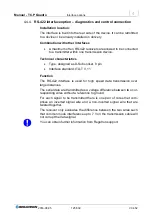
Manual - TC.P Quadro
Internal system communication
2016-08-05
136/330
V04.52
5
5.3.3.
Multi-unit system with TopCon power supplies
5.3.3.1. Master-slave principle on power supplies in the multi-unit system
The set values are provided to the master device, e.g. via HMI or the
PC using the TopControl application.
The master device passes on the parameters to its slaves via the inter-
nal system communication. The individual slave devices in the multi-unit
system convert the set values specified into the related output values.
Limits of a multi-unit system
Only one master is allowed per multi-unit system.
Per multi-unit system at full bandwidth maximum number of de-
vices: 8
Devices such as HMI or RCU also count in a multi-unit system.
A device address is only allowed to occur once in the multi-unit
system.
Several multi-unit systems can be connected via a Multi-Rack
Controller (MRC) to form a large multi-unit system.
Display of the operating parameters for individual devices
The most important operating parameters are sent continuously by the
slave devices to the master and can be displayed there, e. g., using the
TopControl application.
Errors in the multi-unit system
Control of the state information in the multi-unit system:
Slave devices follow the state of the master device.
Each single device (module) can independently enter the
“WARN” or “ERROR” state and trigger the entire system to
change to this state.
Acknowledging an error will affect the entire system.
Addressing of master and slave devices
The addresses of multi-unit system devices comprise an upper
address range (AH) and lower address range (AL).
The device is defined as a master or slave device depending on the
value used for the address.
Master device
AL: 0; AH: 0
Slave device
The value for the address is > 0, whether in the AL or AH ad-
dress range






























